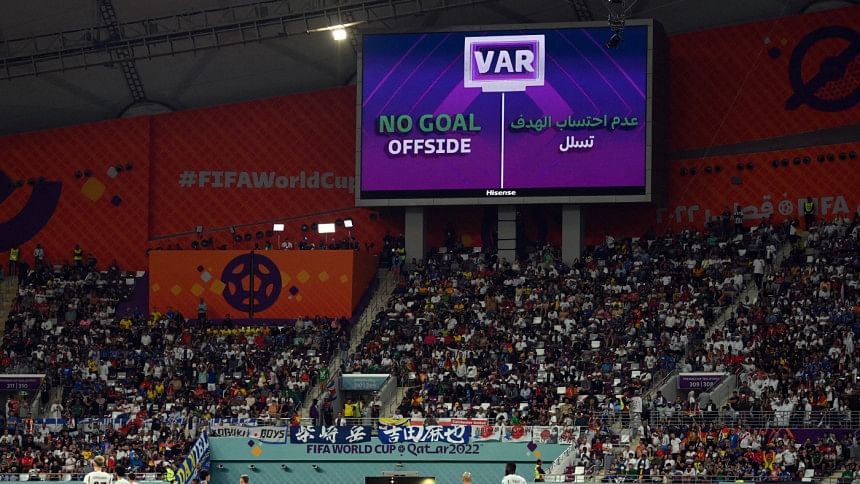Desert fest: New tech, immediate impact

As the minutes ticked by for another video assistant referee (VAR) review after Vinicius Jr. had scored to put Brazil ahead against Switzerland on Monday, apprehension began to grow among the raucous Brazil fans.
They had seen this script before, most notably when Argentina were made to wait before having three of their goals ruled out for offside in a sensational 2-1 loss to Saudi Arabia.
The semi-automated offside system, which has been introduced this World Cup, had the simple aim of shortening the time taken by the VAR to make decisions, as Nicolas Evans, head of football research and standards for FIFA Technology Innovation, revealed.
"We debriefed in 2018 after the World Cup and the biggest area for improvement we saw was the time it took to make offside decisions."
But while most decisions have been quickly caught, the near-infallible nature of the system points to the VAR being the one taking up the lion's share of the time.
That was evident for Vinicius' phantom goal when officials not only took around three minutes to cancel the goal, as Richarlison was offside before the final pass to Vinicius, but also failed to project the 3D renderings of the offside that fans have come to expect.
In fact, there was no other visual cue at all till well after the decision was made and the most likely reason for that is that officials simply did not know where to look. The offside had occurred in the build-up and it can be questioned whether the referees -- like fans watching live -- were caught unaware.
There was another curious moment after Cristiano Ronaldo claimed a goal from a Bruno Fernandes cross. CR7 was insistent that he had gotten the telling touch, but FIFA and Adidas confidently stated after the match he had not. Their confidence led to some bemusement. After all, how could they know?
As it turns out, there is no way they could not have known.
The journey began six years ago, when KINEXON, a huge stakeholder in the performance-tracking world, began working on the device now embedded in the official ball, Al Rihla.
The biggest concern regarding that was whether implanting a device in the heart of the ball would change how it felt and reacted, especially as neither party wanted a repeat of the 'Jabulani', which was criticized even by players at the 2010 World Cup in South Africa.
After the development of the final product, which weighs in at just 14 grams, FIFA blind-tested players during competitions such as the 2021 FIFA Arab Cup in Qatar and the 2021 FIFA Club World Cup in Abu Dhabi.
They even employed a 'mechanical shooter test' in a lab setting, programming a robot to kick the ball with varying speeds, spin and direction. High-speed cameras evaluated the flight of the ball, ensuring that the presence of the sensor did not create abnormal flight paths.
In the case of VAR, this sensor works in tandem with HawkEye, which fans of tennis or cricket will be familiar with. But HawkEye does not only track the ball, it also captures 29 different points from each player's body, including limbs, extended knees and shoulders.
This data is merged with the data from one of the two sensors housed in Al Rihla, the Ultra-wideband (UWB), which provides precise positional data and can transmit that data in real-time to constantly track the ball's position.
KINEXON's system captures the data at 500 frames per second, meaning it generates a new image 500 times per second. Such precision means that their data would have a maximum variance of two milliseconds with true positioning.
All that data is then used to generate 3D renderings, which is what is overlaid onto broadcasts to give fans a direct look at how each reviewed call was decided. Unless, of course, the officials are uncertain about where exactly to look.
A crucial final piece of the process, given that a machine can malfunction without warning, is the human verification process, which, as mentioned before, can take whatever amount of time is required.
Meanwhile, much to Ronaldo's chagrin, there exists a secondary sensor, the Inertial measurement unit (IMU) which detects nuanced movements of an object in space.
So, any time the ball is kicked, headed, thrown or even so much as tapped, the system picks it up.
Still, while there are some who have begrudgingly accepted decisions due to the cutting-edge nature of the tech in play, there is no doubt that crazed sports fans will find a flaw before the end of the World Cup.
For now, that flaw is as harmless, however annoying, as the consumption of a few extra minutes.

 For all latest news, follow The Daily Star's Google News channel.
For all latest news, follow The Daily Star's Google News channel. 



Comments